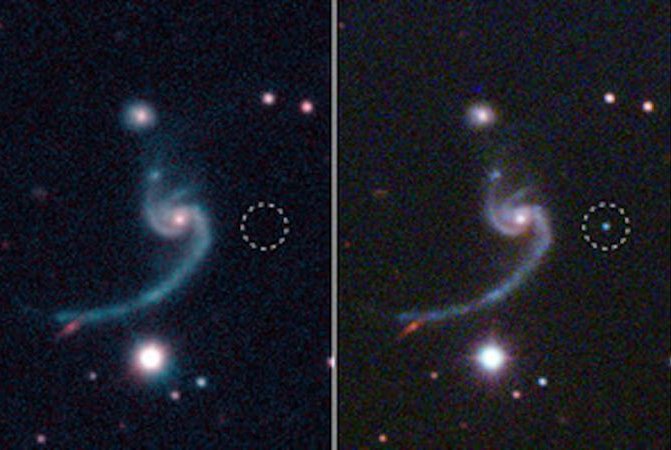The collapsing star only became briefly visible as its surprisingly small supernova flashed in the night sky. Photo by SDSS/Caltech/Keck
Oct. 12 (UPI) -- Astronomers were surprised when the collapse of a massive star yielded a rather puny supernova.
An investigation of the phenomena suggests a companion star robbed the collapsing star of much of its stellar material, limiting the magnitude of the explosion.
"We saw this massive star's core collapse, but we saw remarkably little mass ejected," Kishalay De, grad student at the California Institute of Technology, said in a news release. "We call this an ultra-stripped envelope supernova and it has long been predicted that they exist. This is the first time we have convincingly seen core collapse of a massive star that is so devoid of matter."
When massive stars run out of fuel and collapse in on themselves, the material rebounds outward in dramatic fashion. The violent explosion sends the outer stellar layers into interstellar space, leaving behind a small but extremely dense core, a neutron star.
Because the star exploded, scientists determined the stellar core must have been large enough to collapse. But the diminutive explosion suggested the star was missing a significant amount of matter.
An intimate companion, close enough to siphon gas from its neighbor, was the best explanation. Not only had scientists witnessed a unusual stellar death, they had also observed the birth of a compact neutron star binary system -- a first.
The observations -- detailed this week in the journal Science -- were made possible by a unique astronomical survey, the intermediate Palomar Transient Factory, a nightly scan conducted at the Palomar Observatory. The survey is designed to identify short-lived cosmic phenomena.
"You need fast transient surveys and a well-coordinated network of astronomers worldwide to really capture the early phase of a supernova," said De. "Without data in its infancy, we could not have concluded that the explosion must have originated in the collapsing core of a massive star with an envelope about 500 times the radius of the sun."
Scientists continue to monitor the compact neutron star binary system using a collection of observatories called the GROWTH network. The companions are so close that they will eventually merge. Neutron star mergers can produce gravitational waves -- as was observed in 2017.
Astronomers can learn about the nature of extreme cosmic events by studying the patterns of gravitational waves.















